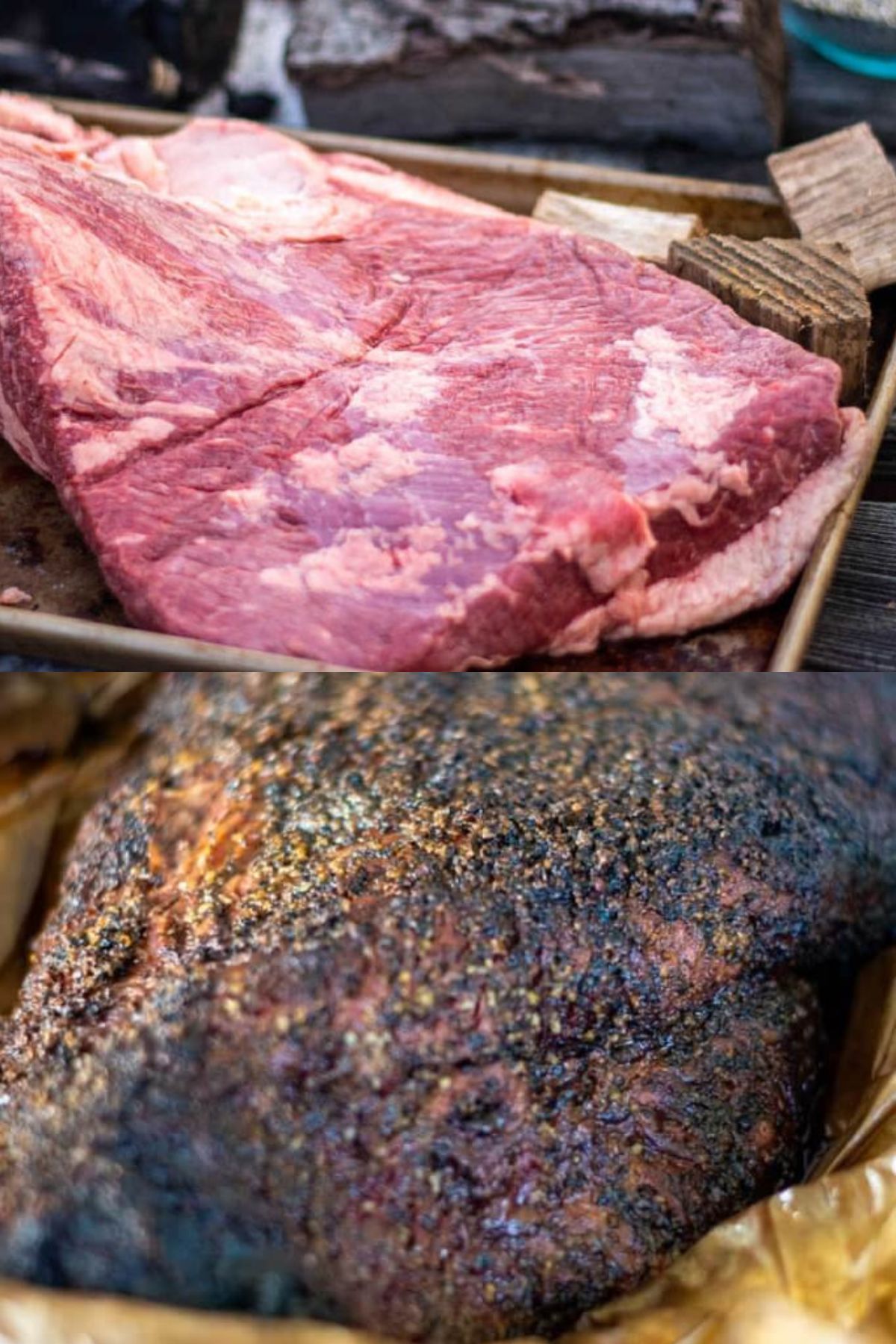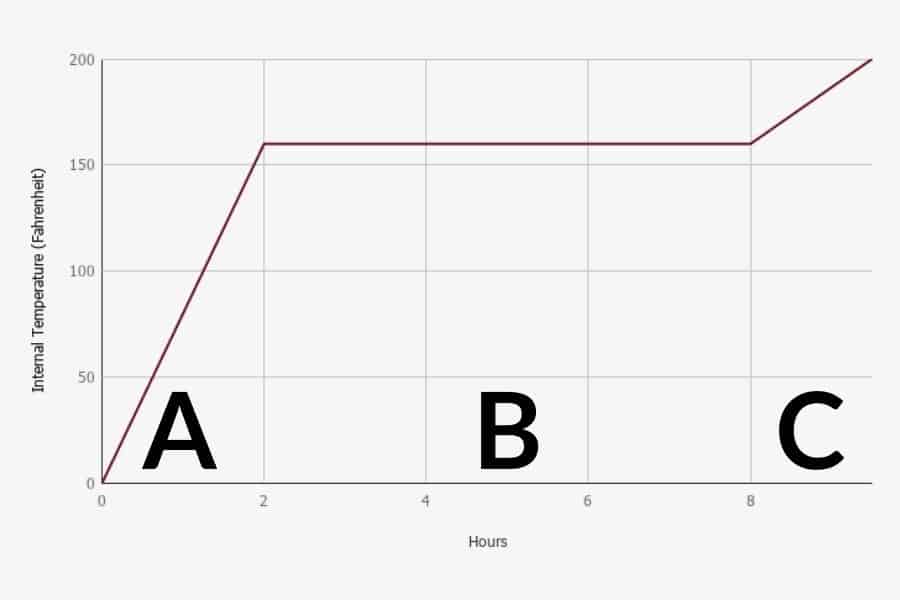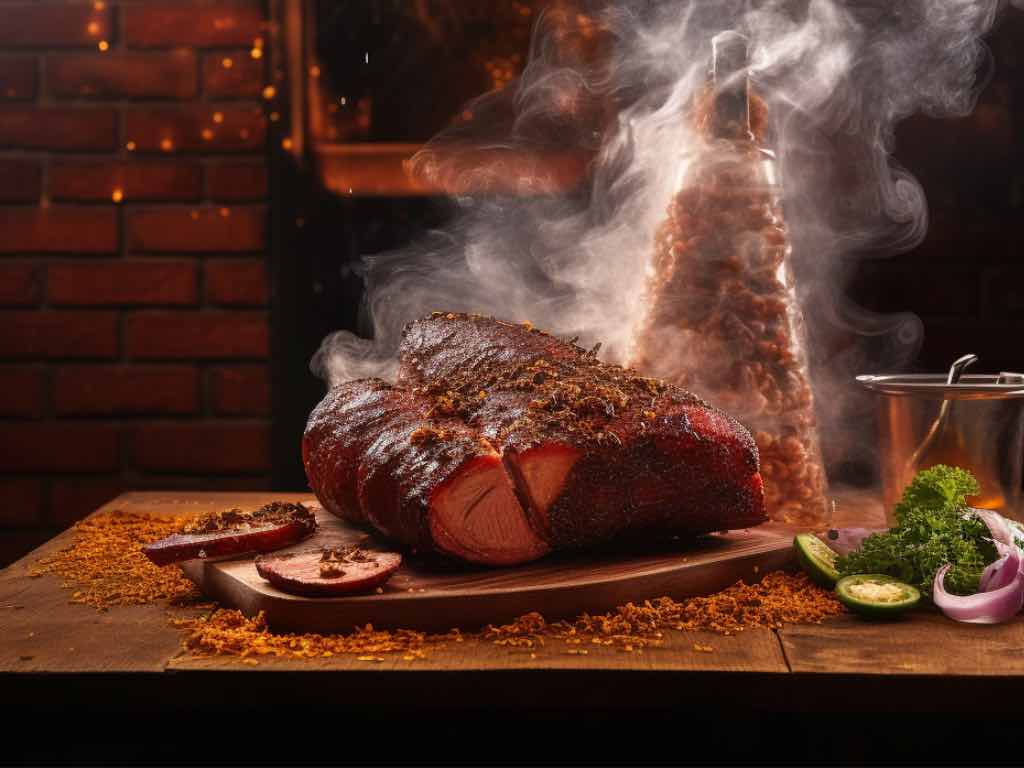
Introduction
The enigmatic brisket stall, often referred to as the barbecue plateau, remains a riddle for many pitmasters. As the brisket’s internal temperature rises during smoking, an unexpected halt in temperature increase occurs, baffling even the most experienced barbecue aficionados. Unveiling the brisket stall requires a journey into the realm of thermodynamics, specifically focusing on the interplay between evaporative cooling and heat conduction.
What Is The Brisket Stall?
The brisket stall is a phenomenon that occurs during the smoking process when the internal temperature of the brisket reaches a certain point and then unexpectedly plateaus for several hours. This stall can be frustrating for pitmasters who are trying to achieve a specific internal temperature before serving the brisket. Understanding the causes and how to overcome the stall is essential for producing consistently delicious barbecue.
During the stall, the evaporative cooling effect comes into play. As the brisket sweats and moisture evaporates from its surface, it cools down the meat, which counteracts the heat being applied during the smoking process. This equilibrium between heat conduction and evaporative cooling causes the stall in temperature increase.
The Importance Of Understanding The BBQ Phenomenon
Understanding the brisket stall is crucial for achieving perfectly smoked brisket. By knowing why the stall occurs, pitmasters can adjust their smoking techniques to overcome it and ensure a more consistent cooking process. This knowledge can lead to more flavorful and tender brisket, as pitmasters can control the timing and temperature to maximize the meat’s juiciness and tenderness.
Furthermore, understanding the thermodynamics behind the brisket stall can empower pitmasters to experiment with different cooking methods and techniques. By manipulating the interplay between evaporative cooling and heat conduction, pitmasters can potentially shorten the stall or even avoid it altogether, resulting in a more efficient smoking process.
| Brisket Stall | Importance of Understanding |
|---|---|
| Occurs during smoking process | Allows for adjustments to cooking techniques |
| Caused by evaporative cooling and heat conduction | Leads to more flavorful and tender brisket |
| Can be overcome or shortened | Enables experimentation and efficiency in smoking process |
In conclusion, the brisket stall is a fascinating and puzzling phenomenon that occurs during the smoking process. Understanding its causes and effects is crucial for pitmasters who want to produce consistently delicious and tender brisket. By harnessing the power of thermodynamics, pitmasters can overcome the stall and experiment with different cooking techniques to elevate their barbecue game.
The Science Behind The Brisket Stall
The enigmatic brisket stall, often referred to as the barbecue plateau, remains a riddle for many pitmasters. As the brisket’s internal temperature rises during smoking, an unexpected halt in temperature increase occurs, baffling even the most experienced barbecue aficionados. Unveiling the brisket stall requires a journey into the realm of thermodynamics, specifically focusing on the interplay between evaporative cooling and heat conduction.
Factors Causing The Stall
The brisket stall is a phenomenon that occurs during the smoking process when the internal temperature of the brisket reaches a certain point and then unexpectedly plateaus for several hours. This stall can be frustrating for pitmasters who are trying to achieve a specific internal temperature before serving the brisket. During the stall, the evaporative cooling effect comes into play. As the brisket heats up, the water within its cells begins to evaporate, cooling down the surface of the meat and counteracting the rise in internal temperature. The breakdown of collagen and connective tissues within the brisket also contributes to the stall.
Understanding The Role Of Collagen And Moisture Loss
Collagen, a protein found in muscle tissues, plays a crucial role in the tenderness and moisture of the brisket. During the smoking process, collagen begins to break down into gelatin, which contributes to the tenderization of the meat. However, this breakdown process requires time and heat to occur, leading to the stall. Additionally, as the brisket sweats and moisture evaporates from its surface, the evaporative cooling effect further prolongs the stall.
By acknowledging the scientific principles behind the stall, pitmasters can transform this mysterious halt into a calculated step toward BBQ perfection. Understanding the causes and effects of the stall enables pitmasters to adjust their smoking techniques to overcome it and produce consistently delicious and tender brisket. They can experiment with different cooking methods and techniques to manipulate the interplay between evaporative cooling and heat conduction, potentially shortening or even avoiding the stall altogether. This knowledge empowers pitmasters to elevate their barbecue game, creating more flavorful and juicy brisket.
The Temperature Range Of The Brisket Stall
The Stall Temperature Range
The brisket stall typically occurs when the internal temperature of the meat reaches around 160 to 165 degrees Fahrenheit. At this temperature range, the collagen and connective tissues in the brisket begin to break down, contributing to the tenderization of the meat. However, this breakdown process requires time and heat, causing the temperature to plateau for several hours. It is during this stall that the evaporative cooling effect, where the water within the brisket evaporates and cools down the surface, also comes into play.
Why It Occurs Around 160 To 165 Degrees
The specific temperature range of 160 to 165 degrees Fahrenheit is significant because it represents the breaking point of the collagen in the brisket. As the temperature rises, the collagen begins to transform into gelatin, which helps to make the meat tender and juicy. However, this transformation process takes time, leading to the stall. Additionally, the moisture loss occurring during the smoking process contributes to the evaporative cooling effect, prolonging the stall.
Understanding the temperature range at which the brisket stall occurs allows pitmasters to plan their cooking techniques accordingly. They can anticipate the stall and adjust their smoking methods to overcome it more efficiently. By experimenting with different cooking methods and applying their knowledge of temperature ranges, pitmasters can manipulate the interplay between evaporative cooling and heat conduction, potentially shortening or even avoiding the stall altogether.
In conclusion, the brisket stall is a natural occurrence during the smoking process, characterized by a halt in the temperature increase of the meat. Understanding the factors causing the stall, such as collagen breakdown and evaporative cooling, allows pitmasters to approach it as a calculated step toward achieving barbecue perfection. By utilizing their knowledge and adjusting their cooking techniques, they can produce consistently delicious and tender brisket that will impress any backyard barbecue gathering.

Duration Of The Brisket Stall
Length Of The Stall
The brisket stall typically lasts for several hours, with the temperature plateauing for an extended period. This stall can be frustrating for pitmasters, as they eagerly await the internal temperature of the brisket to continue rising. However, it is important to understand that this stall is a natural part of the smoking process and is necessary for achieving tender and juicy meat.
Instances Of The Stall Lasting For Over Four Hours
In some cases, the brisket stall can last for more than four hours, further testing the patience of pitmasters. During this time, the temperature may even drop a few degrees, which can be discouraging for those seeking steady progress. However, it is essential to resist the temptation to intervene or adjust the cooking process hastily. The stall is a crucial phase in the breakdown of collagen and connective tissues, ultimately contributing to the tenderness of the brisket.
Managing The Brisket Stall
Tips To Overcome The Stall
During the brisket stall, it is important to resist the urge to rush the cooking process. Patience is key when it comes to creating tender and flavorful brisket. However, there are a few tips that can help pitmasters navigate through this phase more smoothly:
- Spritzing the brisket: Using a water pan and spritzing the brisket with a fine mist of water can create high humidity within the smoker. This helps to avoid the stall by maintaining a moist environment.
- Wrapping the brisket: Wrapping the brisket in peach butcher paper or foil can help push through the stall by stopping the evaporation process. This step retains moisture and heat, allowing the internal temperature of the brisket to continue rising.
Methods To Maintain Moisture And Temperature
In addition to the above tips, there are a few methods that can aid in maintaining moisture and temperature during the brisket stall:
- Water pan: Placing a water pan in the smoker can help create a humid environment which prevents the meat from drying out. This also helps to regulate the temperature and prevent fluctuations.
- Fat side up: When placing the brisket in the smoker, it is recommended to position it with the fat side facing up. This allows the fat to render and baste the meat as it cooks, enhancing the moisture and flavor.
It is important to note that while some competition teams cook at higher temperatures to shorten the stall, the traditional low and slow method is still widely practiced and preferred by many pitmasters. Ultimately, finding the right approach that works for you and your smoker is key to successfully managing and navigating through the brisket stall.
What Happens During The Brisket Stall
Internal Temperature Fluctuations
The brisket stall occurs when the temperature of the meat suddenly stops rising during the smoking process. This stall typically happens around 160 to 165 degrees Fahrenheit. The internal temperature of the brisket may even drop a few degrees during this phase. Pitmasters aiming for a moist and tender brisket usually cook it until the internal temperature reaches around 200 degrees Fahrenheit.
Effects On Tenderness And Moisture Retention
The brisket stall is actually seen as a positive phenomenon by some pitmasters. It provides an opportunity for flavor development and enhanced tenderness. The prolonged stall period allows for the breakdown of collagen and connective tissues in the meat, resulting in a more succulent final product. However, it is important to monitor the internal temperature carefully during this phase to ensure the desired outcome.
Managing The Brisket Stall
Tips To Overcome The Stall
During the brisket stall, it is crucial to resist the temptation to rush the cooking process. To navigate through this phase more smoothly, consider the following tips:
- Spritzing the brisket: Use a water pan and spritz the brisket with a fine mist of water. This helps to maintain a moist environment and prevent the stall.
- Wrapping the brisket: Wrap the brisket in peach butcher paper or foil to stop the evaporation process. This technique retains moisture and heat, allowing the internal temperature to continue rising.
Methods To Maintain Moisture And Temperature
In addition to the above tips, you can utilize the following methods to maintain moisture and temperature during the brisket stall:
- Water pan: Place a water pan in the smoker to create a humid environment that prevents the meat from drying out. It also helps regulate the temperature and prevent fluctuations.
- Fat side up: When placing the brisket in the smoker, position it with the fat side facing up. This allows the fat to render and baste the meat as it cooks, enhancing moisture and flavor.
It is essential to note that while some competition teams cook at higher temperatures to shorten the stall, the traditional low and slow method is still widely practiced and preferred by many pitmasters. Finding the right approach that works for you and your smoker is key to successfully managing and navigating through the brisket stall.
Brisket Stall Vs. Resting Period
Differentiating Between The Stall And Resting
During the smoking process, the brisket stall refers to a period when the internal temperature of the meat stops rising, typically around 160 to 165 degrees Fahrenheit. This can last for several hours and even cause a slight drop in temperature. On the other hand, the resting period occurs after the brisket is removed from the smoker and allows it to relax and reabsorb juices, resulting in a more flavorful and tender end product.
Importance Of Both Stages In The Cooking Process
The brisket stall is a crucial part of the cooking process as it allows for collagen and connective tissues to break down, leading to a more succulent and tender brisket. It also provides an opportunity for flavor development. The resting period, on the other hand, ensures that the brisket retains its moisture and allows the juices to redistribute evenly within the meat. Skipping either stage can result in a less desirable end product.
During the stall, it is important to resist the urge to rush the cooking process. Instead, consider techniques like spritzing the brisket with water or wrapping it in butcher paper or foil to maintain moisture and heat. Additionally, using a water pan in the smoker can help create a humid environment and prevent the meat from drying out during the stall.
In conclusion, both the brisket stall and resting period play vital roles in achieving a delicious and tender brisket. Understanding the science behind these stages and implementing techniques to manage them effectively can greatly enhance the quality of your smoked brisket. So, next time you embark on a brisket smoking adventure, remember to embrace the stall and allow your meat to rest for optimal results.

Brisket Temperature: The Desired Outcome
Ideal Internal Temperature For Moist And Tender Brisket
When cooking brisket, achieving the ideal internal temperature is key to ensure a moist and tender end result. Pitmasters and barbecue enthusiasts often aim for an internal temperature of around 200 degrees Fahrenheit. This temperature allows the collagen in the meat to break down, resulting in a more succulent and melt-in-your-mouth texture.
Reasons To Aim For Around 200 Degrees
There are several reasons why a target temperature of 200 degrees is recommended for brisket:
- Collagen breakdown: The popular belief among pitmasters is that the brisket stall occurs because of the phase change of collagen in the meat. This collagen is responsible for the tough and chewy texture of the brisket. By cooking the brisket to around 200 degrees, the collagen breaks down, transforming the tough meat into tender and delicious bites.
- Flavor development: The longer cooking time required to reach the desired internal temperature allows for flavor development. As the brisket cooks, the fat renders, mixing with the meat’s natural juices, and creating a rich and flavorful taste. Additionally, any rubs or marinades have more time to infuse into the meat, enhancing the overall flavor profile.
- Texture and tenderness: Cooking the brisket to 200 degrees allows the connective tissues to fully soften, making the meat tender and easy to shred or slice. This temperature ensures that the brisket is not only cooked through but also reaches a level of tenderness that will impress any barbecue lover.
In conclusion, aiming for an internal temperature of around 200 degrees Fahrenheit is crucial for achieving a moist, tender, and flavorful brisket. The collagen breakdown, flavor development, and optimal texture all contribute to creating a barbecue masterpiece. So, next time you fire up your smoker, keep an eye on that temperature and get ready to enjoy a mouthwatering brisket.
Conclusion
Understanding And Mastering The Brisket Stall
The enigmatic brisket stall, also known as the barbecue plateau, is a puzzling phenomenon that often perplexes pitmasters. It occurs when the internal temperature of the brisket rises during smoking but unexpectedly halts in temperature increase. This stall is rooted in the interplay between evaporative cooling and heat conduction. By understanding the science behind it, pitmasters can better navigate this challenge and ensure a successful barbecue experience.
Achieving The Perfect Barbecue Result
When cooking brisket, achieving the ideal internal temperature is crucial for a moist and tender end result. Pitmasters and barbecue enthusiasts typically aim for an internal temperature of around 200 degrees Fahrenheit. This temperature allows the collagen in the meat to break down, resulting in a more succulent and melt-in-your-mouth texture.
There are several reasons why a target temperature of 200 degrees is recommended for brisket. Firstly, the breakdown of collagen leads to a transformation of tough meat into tender and delicious bites. Secondly, the longer cooking time required to reach this temperature allows for flavor development. The rendering of fat, mixing with the meat’s natural juices, creates a rich and flavorful taste. Additionally, any rubs or marinades have ample time to infuse into the meat, enhancing the overall flavor profile. Lastly, cooking the brisket to 200 degrees ensures that the connective tissues fully soften, resulting in a tender and easy-to-shred or slice meat.
In conclusion, understanding and mastering the brisket stall is essential for achieving the perfect barbecue result. By aiming for an internal temperature of around 200 degrees Fahrenheit, pitmasters can ensure collagen breakdown, flavor development, and optimal texture. So, next time you fire up your smoker, keep an eye on that temperature and get ready to enjoy a mouthwatering brisket.
FAQ about Brisket Stall Temp: Understanding the BBQ Phenomenon
Q: What is the brisket stall temperature?
A: The brisket stall temperature is a common occurrence during the smoking process of a brisket. It refers to a period where the internal temperature of the meat plateaus for a while, sometimes for several hours, before continuing to rise.
Q: Why does the brisket stall occur?
A: The brisket stall occurs due to the evaporative cooling effect of moisture on the meat’s surface. As the brisket cooks, it releases moisture through the process of evaporation. This evaporation leads to a cooling effect that slows down the temperature increase.
Q: How long does the brisket stall last?
A: The length of the brisket stall can vary depending on various factors such as the size of the brisket, the cooking temperature, and the humidity. On average, the stall can last anywhere from 1 to 4 hours. However, there have been instances where the stall has been known to last even longer.
Q: What should I do when the brisket stalls?
A: When the brisket stalls, it is important to resist the urge to raise the cooking temperature to try to overcome the stall quickly. Patience is key during this phase. Simply monitor the temperature and give the brisket time to push through the stall naturally.
Q: Is it normal for the brisket temperature to plateau for so long?
A: Yes, it is completely normal for the brisket temperature to plateau during cooking. This phenomenon can be frustrating for those who are expecting a steady rise in temperature. However, it is an essential part of the cooking process, and the end result is well worth the wait.
Q: Can I prevent or shorten the brisket stall?
A: While it is not possible to completely prevent the brisket stall, there are a few techniques that can potentially shorten its duration. Wrapping the brisket in foil or butcher paper, known as the Texas crutch method, can help to accelerate the cooking process and reduce the stall time.
Q: How should I monitor the brisket temperature during the stall?
A: To monitor the brisket temperature accurately during the stall, it is recommended to use a reliable meat thermometer. Insert the thermometer probe into the thickest part of the brisket without touching the bone. This will give you an accurate reading of the internal temperature.
Q: What temperature should I aim for when cooking a brisket?
A: The ideal cooking temperature for a brisket is around 225°F to 250°F (107°C to 121°C). However, it is important to note that the stall can occur at any temperature within this range. Adjustments in cooking time may be needed based on your desired level of tenderness.
Q: Can I eat the brisket when it is still in the stall?
A: It is not recommended to eat the brisket when it is still in the stall. The prolonged period within the stall is necessary for the breakdown of connective tissues and the development of the desired texture and flavor. Patience is essential for achieving a juicy and tender brisket.
In summary, the brisket stall temperature is a natural occurrence that happens during the smoking process. It may prolong the cooking time, but with patience and the right technique, you will achieve a mouth-watering brisket that will be well worth the wait.

Keep up with weekly specials through Facebook under “The Grill at Great Bridge.”